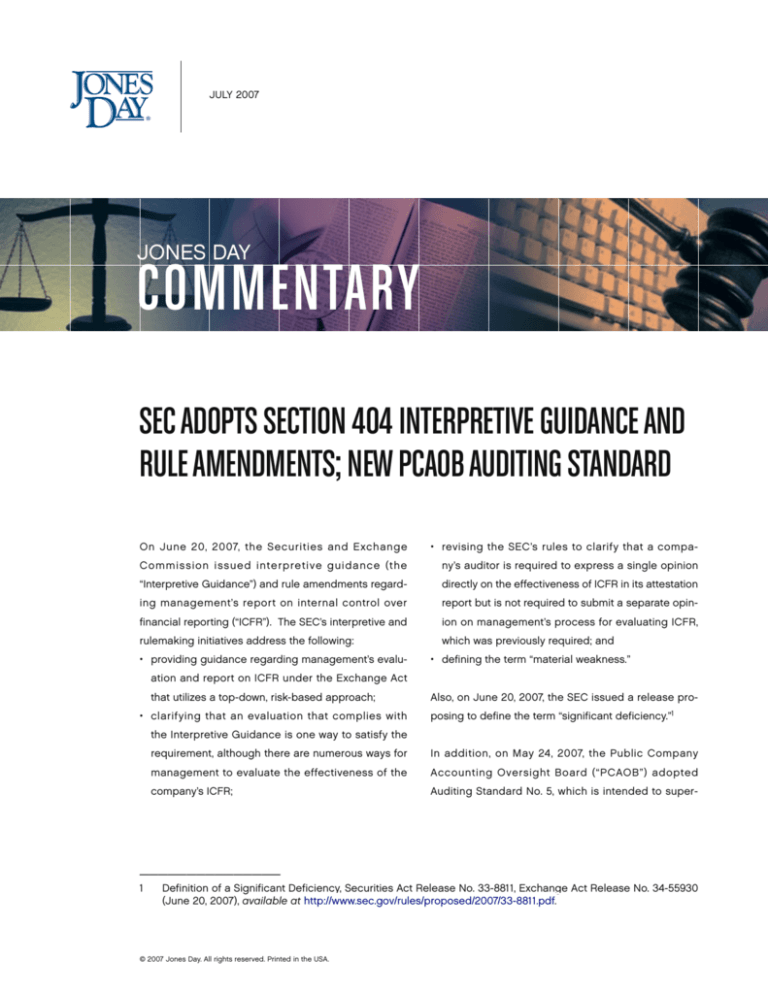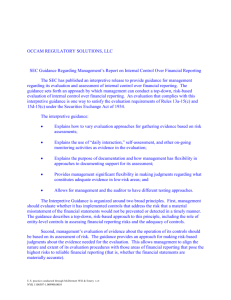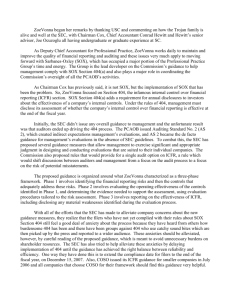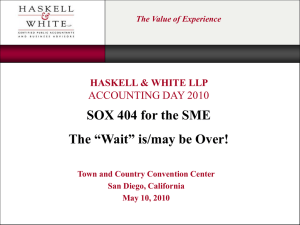
July 2007
JONES DAY
COMMENTARY
SEC Adopts Section 404 Interpretive Guidance and
Rule Amendments; New PCAOB Auditing Standard
On June 20, 2007, the Securities and Exchange
• revising the SEC’s rules to clarify that a compa-
Commission issued interpretive guidance (the
ny’s auditor is required to express a single opinion
“Interpretive Guidance”) and rule amendments regard-
directly on the effectiveness of ICFR in its attestation
ing management’s report on internal control over
report but is not required to submit a separate opin-
financial reporting (“ICFR”). The SEC’s interpretive and
ion on management’s process for evaluating ICFR,
rulemaking initiatives address the following:
which was previously required; and
• providing guidance regarding management’s evalu-
• defining the term “material weakness.”
ation and report on ICFR under the Exchange Act
that utilizes a top-down, risk-based approach;
• clarifying that an evaluation that complies with
Also, on June 20, 2007, the SEC issued a release proposing to define the term “significant deficiency.”1
the Interpretive Guidance is one way to satisfy the
requirement, although there are numerous ways for
In addition, on May 24, 2007, the Public Company
management to evaluate the effectiveness of the
Accounting Oversight Board (“PCAOB”) adopted
company’s ICFR;
Auditing Standard No. 5, which is intended to super-
_______________
1
Definition of a Significant Deficiency, Securities Act Release No. 33-8811, Exchange Act Release No. 34-55930
(June 20, 2007), available at http://www.sec.gov/rules/proposed/2007/33-8811.pdf.
© 2007 Jones Day. All rights reserved. Printed in the USA.
sede the PCAOB’s Auditing Standard No. 2 regarding internal
control
audits. 2
auditor attestation report in each annual report required by
If approved by the SEC, Auditing Standard
Section 13(a) or 15(d) of the Exchange Act. Since the SEC
No. 5 would provide a principles-based approach to internal
issued its rules regarding these ICFR reports in June 2003,3
control audits intended to do the following:
many public companies have struggled to comply with the
• provide a top-down, risk-based approach to focus internal
SEC’s requirements. Absent interpretive guidance regarding
control audits on high-risk areas;
the substance and scope of procedures necessary to meet
these requirements, many companies have spent substantial
• eliminate unnecessary procedures, including the requirement to review management’s evaluation process;
time, effort, and expense in designing and implementing individual ICFR evaluation and reporting procedures.
• scale internal control audits based on the size and complexity of the company, reflecting the SEC’s recognition
that one size does not fit all companies in this regard; and
Cost Associated with Section 404 Compliance
• simplify and clarify the text of the standard, including pro-
Many market participants, including public companies, practi-
viding definitions of “material weakness” and “significant
tioners, and the SEC’s Advisory Committee on Smaller Public
deficiency.”
Companies, have raised concerns regarding the costs associated with the Sarbanes-Oxley Act, in general, and in partic-
These SEC and PCAOB rulemaking initiatives relating to ICFR
ular about Section 404 of the Sarbanes-Oxley Act regarding
are expected to reduce substantially the effort and expense
ICFR.4 The SEC’s proposals are designed to assist com-
required to be incurred by outside auditors and companies,
panies that have already begun providing ICFR reports but
particularly smaller companies, in complying with the ICFR
would like to refine their procedures as well as provide guid-
requirements.
ance that will hopefully minimize the time required to comply
with the rules and the costs for nonaccelerated filers that are
scheduled to begin compliance in their annual reports for the
Background
first fiscal year ending on or after December 15, 2007.
The Interpretive Guidance, rule amendments, and PCAOB
Burdens on Auditors
Auditing Standard No. 5 are largely a response by the SEC
Auditors have expressed similar concerns regarding the uncer-
and PCAOB to the following:
tainty and cost generated by PCAOB Auditing Standard No. 2.
Since Auditing Standard No. 2 became effective, the PCAOB
Uncertainty Associated with Section 404 Compliance
has monitored compliance with the standard and acknowl-
In connection with the passage of the Sarbanes-Oxley Act of
edged that, although the audit of ICFR has produced signifi-
2002, Congress directed the SEC to adopt rules requiring a
cant benefits, these benefits have come at a significant cost.5
management internal control report on ICFR and a related
_______________
2
Public Company Accounting Oversight Board, Auditing Standard No. 5 – An Audit of Internal Control Over Financial Reporting
That is Integrated with an Audit of Financial Statements, and a Related Independence Rule and Conforming Amendments
(May 24, 2007), available at http://www.pcaobus.org/Rules/Docket_021/2007-05-24_Release_No_2007-005.pdf.
3
Management’s Report on Internal Control Over Financial Reporting and Certification of Disclosure in Exchange Act Periodic
Reports, Securities Act Release No. 33-8238, Exchange Act Release No. 34-47986 (June 5, 2003), available at http://www.
sec.gov/rules/final/33-8238.htm.
4
See, e.g., Ivy Xiying Zhang, Economic Consequences of the Sarbanes-Oxley Act of 2002 (2005); Lara Bergen, The SarbanesOxley Act of 2002 And its Effects on American Businesses (2005); Christian Leuz, Alexander Triantis, and Tracy Wang, Why
Do Firms Go Dark?: Causes and Economic Consequences of Voluntary SEC Deregistrations (2006); and Securities and
Exchange Commission Advisory Committee on Smaller Public Companies, Final Report of the Advisory Committee on Smaller
Public Companies to the United States Securities and Exchange Commission (April 23, 2006), available at http://www.sec.gov/info/
smallbus/acspc.shtml.
5
Public Company Accounting Oversight Board, Auditing Standard No. 5 – An Audit of Internal Control Over Financial
Reporting That is Integrated with an Audit of Financial Statements, and a Related Independence Rule and Conforming
Amendments at 2 (May 24, 2007), available at http://www.pcaobus.org/Rules/Docket_021/2007-05-24_Release_No_2007005.pdf.
Avoiding Conflicting Standards
Identification of Risks. The Interpretive Guidance recom-
The joint proposals by the SEC and the PCAOB reflect an
mends that the process begin with management identifying
attempt to more closely align the SEC and PCAOB regulations
financial reporting risks, which are risks that may result in a
relating to ICFR, thereby avoiding potentially inconsistent
material misstatement of financial statements. Management
standards that would create additional work for companies
should use its unique knowledge and understanding of the
and their auditors.
company’s business and procedures to consider the elements of financial reporting. Management may also investigate “what could go wrong” within a financial reporting
SEC Interpretive Guidance, Rule
Amendments, and Proposal
element to determine the sources and likelihood of mis-
Interpretive Guidance6
nies, such as size, complexity, and organizational structure,
Background. In implementing Section 404(a) of the
vary among businesses and that such differences will alter
Sarbanes-Oxley Act, the SEC amended Rules 13a-15 and 15d-
the methods and procedures companies use for identifying
15 of the Exchange Act to require a management evaluation
financial reporting risks. Management’s evaluation of the
and report on ICFR and an attestation report on ICFR by the
risk of misstatement should also consider the company’s
company’s registered public accounting firm.
vulnerability to fraudulent activity and its potential effect on
statements and whether such misstatements could be
material. The guidance notes that characteristics of compa-
the financial statements.
The Guidance. The Interpretive Guidance addresses ICFR
evaluation and reporting, setting forth a top-down, risk-based
Identification of Controls. Once financial reporting risks are
standard for management to conduct its internal control eval-
identified, management should evaluate whether its current
uation in a more effective and efficient manner.
controls, which may consist of policies, procedures, or activities, are adequate to detect, prevent, and address financial
The Evaluation Process
reporting risks. An assessment of entity-level controls and a
Overview. The SEC noted that the objective of ICFR is to pro-
review of locations and business units are appropriate. In that
vide reasonable assurance regarding the reliability of finan-
process, management is not required to identify and evalu-
cial reporting and the preparation of financial statements for
ate all controls that may be in place to address a potential
external purposes in accordance with GAAP. The purpose of
financial reporting risk, and, in fact, it may select the relevant
the annual evaluation of ICFR is to provide management with
controls that can be evaluated most efficiently. Further, man-
a reasonable basis for its determination as to whether there
agement should consider that controls addressing financial
exists a material weakness in ICFR. In general, the manage-
reporting risks may be automatic (dependant on information
ment evaluation process consists of identification of the most
technology), manual, or a combination of both. As a result,
important risks to reliable financial reporting, a determination
management’s evaluation process must take into account
as to whether internal controls are in place to address those
automated systems and procedures. Finally, management
risks, and an assessment as to whether those controls are
must maintain documentary evidence (such as policy manu-
effective for their intended purpose. Under the SEC’s rules,
als, process models, flowcharts, job descriptions, documents,
this evaluation process must be made in accordance with a
internal memoranda, forms, etc.) for its assessment. The
suitable control
framework.7
_______________
6
Commission Guidance Regarding Management’s Report on Internal Control Over Financial Reporting Under Section 13(a)
or 15(d) of the Securities Exchange Act of 1934, Securities Act Release No. 33-8810, Exchange Act Release No. 34-55929
(June 20, 2007), available at http://www.sec.gov/rules/interp/2007/33-8810fr.pdf.
7
For example, the internal control framework established by the Committee of Sponsoring Organizations of the Treadway
Commission (commonly referred to as COSO). A company’s ICFR must contain the elements of internal control expected
to be present and functioning in the internal control system, as specified by the internal control framework selected by the
company.
form and extent of the documentation will vary based on the
ing self-assessment; or a combination of both. As ICFR risk
characteristics of the company.
increases, the evidence obtained usually will be adjusted to
reflect that risk. If the evaluation uncovers a deficiency, man-
Evaluation of Operating Effectiveness of Controls. The
agement must determine whether that deficiency constitutes
Interpretive Guidance provides recommendations for man-
a material weakness.
agement’s evaluation of the operating effectiveness of ICFR.
Management should evaluate whether the internal control pro-
Reporting Considerations
cess is functioning as intended and whether the individuals
Management is required to report control deficiencies, or a
overseeing the process are competent and have the appro-
combination of control deficiencies, that rise to the level of
priate level of authority. Management’s consideration of the
a material weakness in its annual report on the effective-
misstatement risk of a financial reporting element includes
ness of ICFR. Additionally, management must disclose con-
“both the materiality of the financial reporting element and
trol deficiencies that are considered significant deficiencies
the susceptibility of the underlying account balances, trans-
to the company’s audit committee and its external auditors.
actions or other supporting information to a misstatement
The Interpretive Guidance indicates that an evaluation of the
that could be material to the financial statements.” The guid-
severity of a control deficiency should include quantitative
ance recommends increasing management’s assessment
and qualitative factors. The guidance provides risk factors
of misstatement risk for a financial reporting element as the
that affect whether there is a reasonable probability that a
materiality of the financial reporting element increases and
deficiency will result in a misstatement and factors that affect
as the financial reporting element becomes more prone to
the magnitude of the misstatement that might result from a
material misstatement.
deficiency. The guidance also outlines specific situations
that should be evaluated to determine if a deficiency exists,
Management should also focus the evaluation on high-risk
such as the identification of fraud, restatement of previously
areas, including related party transactions, critical account-
issued financial statements, and ineffective oversight over
ing policies, and related critical accounting estimates. In
financial reporting and internal control by the company’s
considering whether a control might fail, management
audit committee.
should consider:
• the type of control and how frequently it operates;
Additionally, the guidance indicates that management should
• the complexity of the control;
clearly disclose its assessment of the effectiveness of ICFR
• the risk of management override;
without qualification or exception. If a material weakness
• the judgment required to operate the control;
exists, management may not state that ICFR is effective over-
• the competence of the personnel who perform the control
all but may identify controls that are ineffective for specific
or monitor its performance;
reasons. This is clearly intended to limit the spin companies
may use in presenting negative information to the market.
• whether there have been changes in key personnel who
either perform the control or monitor its performance;
The guidance adds that companies should consider including the following in their disclosure:
• the nature and materiality of misstatements that the control
is intended to prevent or detect;
• the nature of any material weakness;
• the degree to which the control relies on the effectiveness
• its impact on the company’s financial reporting and its
of other controls; and
ICFR; and
• the evidence of the operation of the control from prior
• management’s current plans, if any, or actions already
year(s).
undertaken, for remediating the material weakness.
Evaluation methods and procedures will vary from company
Companies should also consider disclosing the cause of the
to company and, depending on the facts and circumstances,
control deficiency and the potential impact of each particular
could consist of direct testing; ongoing monitoring, includ-
material weakness.
Finally, although no SEC regulation requires management
that a material misstatement of the registrant’s annual or
to reassess or revise its conclusion on ICFR in the event of
interim financial statements will not be prevented or detected
a restatement of financial statements, the guidance recom-
on a timely basis.”9 Significantly, the probability standard in
mends an assessment of whether the original disclosures
the definition is a “reasonable possibility,” a higher standard
remains appropriate and whether modification of or supple-
than the previous “more than a remote likelihood.”
ment to the original disclosure is required. Management
should also determine whether an inability to access cer-
Auditor Attestation Report Amendments
tain controls as part of the evaluation process is significant
Background. Under Rule 2-02(f) of Regulation S-X, a com-
enough to conclude that ICFR is ineffective.
pany’s registered public accounting firm must provide an
attestation report on management’s assessment of ICFR.
Specifically, the rule requires an opinion of the accountant as
Rule Amendments
8
to whether management’s assessment of the effectiveness of
the registrant’s ICFR is fairly stated in all material respects.
Safe Harbor for a Management Evaluation that Complies
The required assessment is an appraisal of management’s
with the SEC’s Interpretive Guidance
disclosure regarding the effectiveness of the company’s
The SEC has adopted an amendment to Rules 13a-15(c) and
ICFR, rather than an assessment of management’s evaluation
15d-15(c) of the Exchange Act to clarify that a management
process. As a result of confusion among accountants about
evaluation conducted in accordance with the Interpretive
whether they are required to provide a report on manage-
Guidance satisfies the evaluation requirement in the rules.
ment’s conclusion, evaluation process, or both, the SEC has
The effect of the amendment is to provide a safe harbor for
amended Rule 2-02(f) of Regulation S-X to clarify the rule.
companies that conduct their evaluation in accordance with
the Interpretive Guidance. The SEC recognized that many
The Amendment. The Amendment does the following:
companies have already implemented management evalua-
• modifies Rule 2-02(f) to clarify that a company’s auditor is
tion procedures and commented that choosing to follow the
required to express a single opinion directly on the effec-
Interpretive Guidance is voluntary. The SEC noted specifi-
tiveness of ICFR in its attestation report but is not required
cally that companies that have already implemented evalu-
to submit a separate opinion on management’s process for
ation procedures do not need to alter those procedures to
evaluating ICFR;
align them with the Interpretive Guidance.
• revises Rule 2-02(f) to clarify the rare circumstances in
which the accountant would be unable to express an opin-
Definition of “Material Weakness”
ion; and
Background. Until now, the SEC chose to refer to accounting
• revises the definition of “attestation report” in Rule 1-
literature to provide a definition regarding the term “mate-
02(a)(2) of Regulation S-X to conform the definition to the
rial weakness,” rather than include a definition of the term in
clarification of Rule 2-02(f) of Regulation S-X.
its rules. As a result of the importance of the term “material
weaknesses” relating to ICFR, the SEC decided to provide a
Although auditors are no longer required to provide a sep-
definition of the term.
arate opinion on management’s evaluation procedures,
PCAOB Auditing Standard No. 5 requires auditors to evaluate
The Amendment. The SEC has amended Rule 12b-2 of the
whether management included all the required disclosures it
Exchange Act and Rule 1-02 of Regulation S-X to define
its assessment report.
“material weakness” as “a deficiency, or a combination of deficiencies, in ICFR such that there is a reasonable possibility
_______________
8
Amendments to Rules Regarding Management’s Report on Internal Control Over Financial Reporting, Securities Act Release
No. 33-8809, Exchange Act Release No. 34-55928 (June 20, 2007), available at http://www.sec.gov/rules/final.shtml.
9
Id. at 17.
• provide a top-down, risk-based approach to focus internal
Proposed Amendment to Define
“Significant Deficiency”
control audits on high-risk areas;
• eliminate unnecessary procedures, including the requirement to review management’s evaluation process;
Background. The SEC’s rules implementing the requirements
of the Sarbanes-Oxley Act require management to disclose
• scale internal control audits based on the size and com-
all “significant deficiencies” to the audit committee and exter-
plexity of the company reflecting the SEC’s recognition that
nal auditors, but the SEC did not define that term. Instead,
one size does not fit all companies in this regard; and
• simplify the text of the standard, including providing defini-
the SEC relied on interpretations under generally accepted
tions of “material weakness” and “significant deficiency.”
auditing standards and interpretations of the PCAOB.
The Proposal. Because the term appears in Sections 302
Auditing Standard No. 5 is subject to review, comment, and
and 404 of the Sarbanes-Oxley Act, and to enable manage-
final rulemaking action by the SEC.
ment to refer to SEC rules and guidance rather than auditing
standards, the SEC has proposed defining “significant defi-
Differences from Auditing Standard No. 2
ciency.” The proposal would amend Exchange Act Rule 12b-2
Alignment of PCAOB and SEC Guidance. One of the con-
and Rule 1-02 of Regulation S-X to define the term “significant
cerns expressed by market participants regarding the ICFR
deficiency” as “a deficiency, or a combination of deficiencies,
requirements has been the lack of consistency between the
in internal control over financial reporting that is less severe
regulations of the SEC and PCAOB. With the issuance of the
than a material weakness, yet important enough to merit
Interpretive Guidance and Auditing Standard No. 5, the two
attention by those responsible for oversight of a registrant’s
regulatory bodies attempted to eliminate a number of signifi-
financial
cant differences. For example, Auditing Standard No. 5 uti-
reporting.”10
lizes the same definition of “material weakness” as adopted
Unlike the definition of “material weakness,” the definition of
by the SEC and employs the same definition of “significant
“significant deficiency” would not specifically include a like-
deficiency” proposed by the SEC.
lihood component but would instead rely on the sufficient
and appropriate judgment of management in deciding what
Top-Down Approach and Emphasis on Fraud Controls. As
deficiencies should be reported to the auditors and the
mentioned above, Auditing Standard No. 5 provides a top-
audit committee.
down, risk-based approach to focus internal control audits
on high-risk areas. According to the PCAOB, this approach
utilizes the same principles that apply to financial statement
PCAOB Auditing Standard No. 5
audits—“the auditor determines the areas of focus through
The Standard
relevant assertions.” The PCAOB chose this method over a
Auditing Standard No. 5 provides a principles-based
specific requirements approach, which the PCAOB feared
approach to internal control audits, which the PCAOB views
would lead to a checklist approach. In focusing on high-risk
as refinements, rather than significant shifts in approach. The
areas, Auditing Standard No. 5 also emphasizes the impor-
standard is intended to:
tance of fraud controls in preventing misstatements.
the identification of significant accounts and disclosures and
_______________
10 Definition of a Significant Deficiency, Securities Act Release No. 33-8811, Exchange Act Release No. 34-55930 at 6 (June 20,
2007), available at http://www.sec.gov/rules/proposed/2007/33-8811.pdf.
Elimination of Unnecessary Procedures. Auditing Standard
Lawyer Contacts
No. 5 eliminates procedures the PCAOB views as unnecessary.
Specifically, Auditing Standard No. 5 removes the requirement
For further information, please contact your principal Firm
to review management’s evaluation process and indicates
representative or one of the lawyers listed below. General
that an opinion on management’s evaluation is not required.
e-mail messages may be sent using our “Contact Us” form,
Auditing Standard No. 5 also permits auditors to utilize knowl-
which can be found at www.jonesday.com.
edge gained in previous years’ audits and use the work of others to evaluate the effectiveness of controls. Although Auditing
Thomas C. Daniels
Standard No. 5 removes the requirement of a walkthrough, the
1.216.586.7017
PCAOB stresses that in many cases a walkthrough is appropri-
tcdaniels@jonesday.com
ate to focus auditors on objectives and not mechanics. Finally,
Auditing Standard No. 5 emphasizes a risk-based approach to
Alexander A. Gendzier
multiple location evaluations by requiring auditors to correlate
1.212.326.7821
the amount of audit attention devoted to the location or busi-
agendzier@jonesday.com
ness unit with the degree of
risk.11
Christopher M. Kelly
Scaled Internal Control Audits. In Auditing Standard No. 5,
1.216.586.1238/1.212.326.3438
the PCAOB recognized that “[t]he size and complexity of the
ckelly@jonesday.com
company, its business processes, and business units, may
affect the way in which the company achieves many of its
Richard M. Kosnik
control objectives” and “might affect the risks of misstate-
1.212.326.3437
ment and the controls necessary to address those
risks.”12
rkosnik@jonesday.com
Accordingly, Auditing Standard No. 5 incorporates scaling
Timothy J. Melton
concepts throughout the standard.
1.312.269.4154
tjmelton@jonesday.com
Simplified Standard. Auditing Standard No. 5 provides a
plain-English, principles-based approach to audits on ICFR
that should be easier for auditors and companies to interpret
and implement.
_______________
11
Public Company Accounting Oversight Board, Auditing Standard No. 5 – An Audit of Internal Control Over Financial Reporting
That is Integrated with an Audit of Financial Statements, and a Related Independence Rule and Conforming Amendments ¶
B10 (May 24, 2007), available at http://www.pcaobus.org/Rules/Docket_021/2007-05-24_Release_No_2007-005.pdf.
12
Id. at ¶ 13.
Jones Day publications should not be construed as legal advice on any specific facts or circumstances. The contents are intended for general information purposes only and may not be quoted or referred to in any other publication or proceeding without the prior written consent
of the Firm, to be given or withheld at our discretion. To request reprint permission for any of our publications, please use our “Contact Us”
form, which can be found on our web site at www.jonesday.com. The mailing of this publication is not intended to create, and receipt of it
does not constitute, an attorney-client relationship. The views set forth herein are the personal views of the authors and do not necessarily
reflect those of the Firm.









